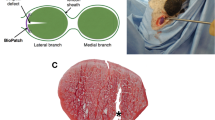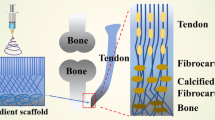Abstract
Objective
To investigate whether electrospun silk fibroin (SF) mat wrapping could enhance tendon-bone healing of soft tissue graft.
Results
Rabbit bone marrow-derived mesenchymal stem cells proliferated well on electrospun SF mat. The autologous Achilles tendon wrapped with electrospun SF mat was transplanted into the bone tunnel (experimental group) in a rabbit extra-articular model, while the unwrapped tendon was transplanted as control group. The electrospun SF mat wrapping could enhance tendon-bone healing of autologous tendon evaluated by micro-computed tomography scanning, histological examination and mechanical testing. At 6 and 12 weeks post-operatively, the failure loads of experimental group were both significantly higher than those of control group (40.5 ± 6.3 vs. 31.8 ± 4.6 N, P = 0.039 at 6 weeks; 67.1 ± 9. vs. 52.2 ± 4.7 N, P = 0.012 at 12 weeks).
Conclusion
The electrospun SF mat wrapping could enhance tendon-bone healing of soft tissue graft.





Similar content being viewed by others
References
Cai Q, Shi Y, Shan D et al (2015) Osteogenic differentiation of MC3T3-E1 cells on poly(l-lactide)/Fe3O4 nanofibers with static magnetic field exposure. Mater Sci Eng C 55:166–173
Catto V, Fare S, Cattaneo I et al (2015) Small diam. electrospun silk fibroin vascular grafts: mechanical properties, in vitro biodegradability, and in vivo biocompatibility. Mater Sci Eng C 54:101–111
Chechik O, Amar E, Khashan M, Lador R, Eyal G, Gold A (2013) An international survey on anterior cruciate ligament reconstruction practices. Int Orthop 37:201–206
Chen CH, Chen WJ, Shih CH, Chou SW (2004) Arthroscopic anterior cruciate ligament reconstruction with periosteum-enveloping hamstring tendon graft. Knee Surg Sport Traumatol Arthrosc 12:398–405
Chen CH, Chang CH, Su CI et al (2010) Arthroscopic single-bundle anterior cruciate ligament reconstruction with periosteum-enveloping hamstring tendon graft: clinical outcome at 2 to 7 years. Arthroscopy 26:907–917
Chen W, Shao Y, Li X, Zhao G, Fu J (2014) Nanotopographical Surfaces for Stem Cell Fate Control: engineering Mechanobiology from the Bottom. Nano Today 9:759–784
Chen J, Yan C, Zhu M et al (2015) Electrospun nanofibrous SF/P(LLA-CL) membrane: a potential substratum for endothelial keratoplasty. Int J Nanomed 10:3337–3350
Dinis TM, Elia R, Vidal G et al (2015) 3D multi-channel bi-functionalized silk electrospun conduits for peripheral nerve regeneration. J Mech Behav Biomed 41:43–55
Dong Y, Zhang Q, Li Y, Jiang J, Chen S (2012) Enhancement of tendon-bone healing for anterior cruciate ligament (ACL) reconstruction using bone marrow-derived mesenchymal stem cells infected with BMP-2. Int J Mol Sci 13:13605–13620
Engler AJ, Sen S, Sweeney HL, Discher DE (2006) Matrix elasticity directs stem cell lineage specification. Cell 126:677–689
Guo JH, Liu Y, Lv ZJ et al (2015) Potential Neurogenesis of Human Adipose-Derived Stem Cells on Electrospun Catalpol-Loaded Composite Nanofibrous Scaffolds. Ann Biomed Eng 43:2597–2608
Han F, Zhang P, Sun Y, Lin C, Zhao P, Chen J (2015) Hydroxyapatite-doped polycaprolactone nanofiber membrane improves tendon-bone interface healing for anterior cruciate ligament reconstruction. Int J Nanomed 10:7333–7343
Hashimoto Y, Naka Y, Fukunaga K, Nakamura H, Takaoka K (2011) ACL reconstruction using bone-tendon-bone graft engineered from the semitendinosus tendon by injection of recombinant BMP-2 in a rabbit model. J Orthop Res 29:1923–1930
Jeong L, Kim MH, Jung JY, Min BM, Park WH (2014) Effect of silk fibroin nanofibers containing silver sulfadiazine on wound healing. Int J Nanomed 9:5277–5287
Kim BS, Park KE, Kim MH, You HK, Lee J, Park WH (2015) Effect of nanofiber content on bone regeneration of silk fibroin/poly(epsilon-caprolactone) nano/microfibrous composite scaffolds. Int J Nanomed 10:485–502
Kuang GM, Yau WP, Lu WW, Chiu KY (2014) Local application of strontium in a calcium phosphate cement system accelerates healing of soft tissue tendon grafts in anterior cruciate ligament reconstruction: experiment using a rabbit model. Am J Sport Med 42:2996–3002
Li M, Ogiso M, Minoura N (2003) Enzymatic degradation behavior of porous silk fibroin sheets. Biomaterials 24:357–365
Marelli B, Alessandrino A, Fare S, Freddi G, Mantovani D, Tanzi MC (2010) Compliant electrospun silk fibroin tubes for small vessel bypass grafting. Acta Biomater 6:4019–4026
Midha S, Murab S, Ghosh S (2016) Osteogenic signaling on silk-based matrices. Biomaterials 97:133–153
Moses B, Orchard J, Orchard J (2012) Systematic review: annual incidence of ACL injury and surgery in various populations. Res Sport Med 20:157–179
Poolman RW, Farrokhyar F, Bhandari M (2007) Hamstring tendon autograft better than bone patellar-tendon bone autograft in ACL reconstruction: a cumulative meta-analysis and clinically relevant sensitivity analysis applied to a previously published analysis. Acta Orthop 78:350–354
Sekiya N, Ichioka S, Terada D, Tsuchiya S, Kobayashi H (2013) Efficacy of a poly glycolic acid (PGA)/collagen composite nanofibre scaffold on cell migration and neovascularisation in vivo skin defect model. J Plast Surg Hand Surg 47:498–502
Shao Z, Vollrath F (2002) Surprising strength of silkworm silk. Nature 418:741
Sheikh FA, Ju HW, Lee JM et al (2015) 3D electrospun silk fibroin nanofibers for fabrication of artificial skin. Nanomed 11:681–691
Yin Z, Chen X, Chen JL et al (2010) The regulation of tendon stem cell differentiation by the alignment of nanofibers. Biomaterials 31:2163–2175
Yin Z, Chen X, Song HX et al (2015) Electrospun scaffolds for multiple tissues regeneration in vivo through topography dependent induction of lineage specific differentiation. Biomaterials 44:173–185
Zhang W, Pan W, Zhang M, Wei Y (2011) In vivo evaluation of two types of bioactive scaffold used for tendon-bone interface healing in the reconstruction of anterior cruciate ligament. Biotechnol Lett 33:837–844
Zhao X, Jiang S, Liu S et al (2015) Optimization of intrinsic and extrinsic tendon healing through controllable water-soluble mitomycin-C release from electrospun fibers by mediating adhesion-related gene expression. Biomaterials 61:61–74
Acknowledgments
This study was funded by the National 863 Hi-tech Project (2015AA033703) from the Ministry of Science and Technology of the People’s Republic of China.
Author information
Authors and Affiliations
Corresponding author
Ethics declarations
Conflict of interest
The authors declare that they have no conflict of interest.
Additional information
An erratum to this article can be found at http://dx.doi.org/10.1007/s10529-016-2171-7.
Rights and permissions
About this article
Cite this article
Zhi, Y., Liu, W., Zhang, P. et al. Electrospun silk fibroin mat enhances tendon-bone healing in a rabbit extra-articular model. Biotechnol Lett 38, 1827–1835 (2016). https://doi.org/10.1007/s10529-016-2158-4
Received:
Accepted:
Published:
Issue Date:
DOI: https://doi.org/10.1007/s10529-016-2158-4




